 |
||
|
||
| ||
 This is our second review aimed at examination of a new series of video cards from ATI and the third one studying the RADEON 8500. In the previous review where we considered video cards from PowerMagic we focused on the new drivers from ATI of v7.206 which support the SmoothVision. In that review we also took a look at quality of operation of the RADEON 8500 (and partially RADEON 7500) in 3D graphics with the new drivers. Today we will continue our investigation. For comparison we will use the results obtained for the NVIDIA GeForce3. The RADEON 8500 will be for a certain time a center of attention, and as far as we cover all issues connected with this GPU we will return to the RADEON 7500. As you remember, there are two RADEON 8500 based cards: those sold by ATI and equipped with a chip and memory working at 275/275 (550) MHz, and those coming from ATI's partners with the frequencies reduced to 250/250 (500) MHz. The latter ones are known as RADEON 8500 LE. But either the decision to divide such models was too late, or the partners just ignored it, but currently there are a lot of RADEON 8500 based cards from Chinese firms which operate at 250/250 (500) MHz and are not marked as "LE". As a result, some unscrupulous vendors sell such cards under the guise of normal 275 MHz ones. That is why you should remember that all RADEON 8500 cards from Chinese known or noname firms are, in fact, based on the RADEON 8500 LE regardless of what is written on the box. Only a Retail package from ATI guarantees that inside there is a card running at 275/275 (550) MHz. Like the GeForce 3, the RADEON 7500/8500 will be examined for a long time with detailed investigations of its possibilities and functions. Theoretical materials and reviews of video cards which concern functional properties of the GPU ATI RADEON 8500/7500
Have you noticed that there are a lot of companies appeared just a little time ago which have beautiful names and which produce high-quality video cards! And all of them are from China. Why did they "hatched out" only when the new RADEON appeared? I think you see what I'm getting at. I just want to say that Manli is the only company which is not afraid of producing RADEON cards under its own name. CardsFirst of all, I'd like to introduce you a new version of the PowerMagic video card on the RADEON 7500. Just after our review on the family of such cards the company announced a new version of the RADEON 7500 product. PowerMagic RADEON 7500 (new revision)The PowerMagic RADEON 7500 card has an AGP x2/x4 interface, 64 MBytes DDR SDRAM located in 8 chips on the right and back sides of the PCB.    ESMT produces memory chips with 4 ns access time which corresponds to 250 (500) MHz. The memory works at the rated for RADEON 7500 frequency of 230 (460) MHz. The chip operates at the reduced frequency - 270 MHz (against ATI's 290 MHz). We can see again that the chips of the partners work at the lower frequency than those from ATI itself. It is interesting that while the RADEON 8500 LE is announced, nobody heard about a RADEON 7500 LE. However, cards on the RADEON 7500 with a core running at 250 (!) MHz are already available. Beware of them! The design of the new revision is identical to the reference one, and you can compare the red card with the green one examined earlier: PowerMagic RADEON 7500 (produced by PowerMagic) 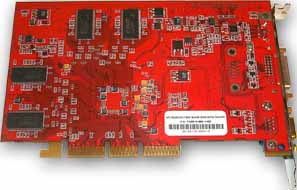 PowerMagic RADEON 7500 (produced by ATI)  As you can see, they differ in the components and a cooler on the GPU. The former difference is quite important as it affects 2D quality and stability. The accessories are the same as in the previous revision. In closing I should add that this sample doesn't yield to the reference card in 2D quality and stability of operation. OverclockingIn the PowerMagic RADEON 7500 (red edition) both the chip and the memory overclocksquite well: 355 MHz and 255 (510) MHz respectively. Note:
Manli RADEON 8500The Manli RADEON 8500 card has an AGP x2/x4 interface, 64 MB DDR SDRAM located in 8 chips on the right and back sides of the PCB.    Hynix produces memory chips with 3.6 ns access time which corresponds to 277 (554) MHz. As you can see, the memory is identical to the one we saw in the previous reviews. But both the chip and the memory work at 250/250 (500) MHz. It means that we, in fact, have RADEON 8500 LE recently announced by ATI. However, the developer doesn't indicate that it is an underclocked RADEON. This card not just follows the reference sample, but this card is from ATI, i.e. THE SAME: Manli RADEON 8500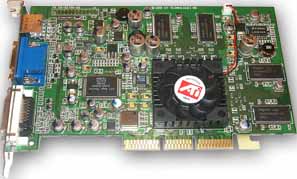  PowerMagic RADEON 8500  As you can see, the only difference is a sticker from Manli. Supposedly, ATI places orders with plants in China, and ATI's partners can purchase finished products from these plants against contract. It is possible that in the beginning it was so, but we have already received the first board produced exactly by the Chinese company (PowerMagic). That is why I think we will soon get more video cards on the RADEON 7500/8500 "not-from-ATI". The Manli RADEON 8500 has VGA, DVI and TV-out. (We have already written about this.)  The card ships in a Retail package. Accessories:
OverclockingThe Manli RADEON 8500 is able to work at a maximum of 275 MHz. On one hand, the memory is the same as in the card operating at 275 MHz and the memory controller allows changing its frequency regardless of the chip speed, but it was impossible to overclock the memory higher than the definite values. Maybe it is done purposely (in the BIOS) so that overclocked cards from partners don't hamper sales of Retail versions from ATI. Note:
Manli RADEON 7500The Manli RADEON 7500 card has an AGP x2/x4 interface, 64 MB DDR SDRAM located in 8 chips on the right and back sides of the PCB.   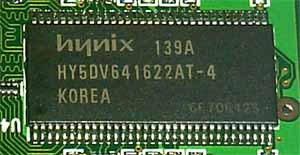 Hynix produces memory chips with 4 ns access time which corresponds to 250 (500) MHz. The memory works at the rated for RADEON 7500 frequency of 230 (460) MHz. The chip is less speedy as it should be - 270 MHz (against ATI's 290 MHz). The card is produced by ATI: Manli RADEON 7500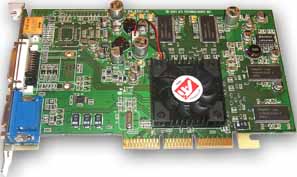 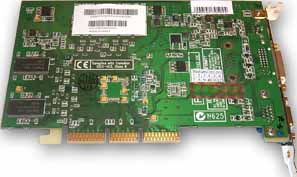 PowerMagic RADEON 7500  The difference is again only in PM letters on the cooler.  The card ships in a Retail package. Accessories:
OverclockingThe Manli RADEON 7500 shows an excellent might - the core works flawlessly at 350 MHz, and the memory runs at 255 (510) MHz. Note:
Sunrich RADEON 8500The Sunrich RADEON 8500 card has an AGP x2/x4 interface, 64 MB DDR SDRAM located in 8 chips on the right and back sides of the PCB.    Hynix produces memory chips with 3.6 ns access time which corresponds to 277 (554) MHz. But both the chip and the memory work at 250/250 (500) MHz. And again it is a copy of the ATI's card: Sunrich RADEON 8500  On the back side there is a sticker with a serial number from this unknown Chinese manufacturer. The Sunrich RADEON 8500 is equipped with VGA, DVI and TV-out.  The card ships in a Retail package. Accessories:
Look at the sticker on the box:  The lie is evident. There is no doubt that this is a usual card from ATI with 64 MBytes of video memory. OverclockingTraditionally, the highest level such card can reach is 275 MHz (though this one worked rather good at 280 MHz as well). It seems that the assumption about artificial slowing down of the cards is true. At least, it is true for memory. Note:
Sunrich RADEON 7500The Sunrich RADEON 7500 card has an AGP x2/x4 interface, 64 MB DDR SDRAM located in 8 chips on the right and back sides of the PCB.    Hynix produces memory chips with 4 ns access time which corresponds to 250 (500) MHz. The memory works at the rated for RADEON 7500 frequency of 230 (460) MHz. The chip is less speedy as it should be - 270 MHz (against ATI's 290 MHz). The card is again from ATI: Sunrich RADEON 7500  PowerMagic RADEON 7500  Everything that can be said about it was already said above :-)  The card ships in a Retail package. Accessories:
Please, look again at the sticker on the box:  Well, the situation is the same as for the RADEON 8500 of this company. OverclockingLike other similar cards the Sunrich RADEON 7500 scores excellent results in overclocking the core (up to 353 MHz!) and the memory (up to 260 (520) MHz). Note:
Installation and driversTest system for the PowerMagic cards:
During the tests we used ATI drivers of v7.189, v7.191 and v7.206, VSync was off, the S3TC technology was enabled. THIS REVIEW CONTAINS NO PERFORMANCE TESTS AS ALL THE CARDS IN QUESTION ARE IDENTICAL IN SPEED CHARACTERISTICS TO THOSE WE TESTED THE LAST TIME. YOU CAN TAKE THE CORRESPONDING INFORMATION IN THE PowerMagic RADEON 7500/8500 review WHICH IS THE FIRST PART OF OUR SURVEY. Test results, 3D qualityThe performance results can be found in this article. 3DMark2001And now we are going to compare some types of
AA obtained on both cards. ATI RADEON 8500 SmoothVision 4x vs NVIDIA GeForce3 MSAA 4xATI RADEON 8500 SmoothVision 2x vs NVIDIA GeForce3 QuincunxATI RADEON 8500 SmoothVision 4x vs NVIDIA GeForce3 Quincunx+Anisotropic
We have chosen such configurations according to the performance decrease. So, if a user prefers quality to speed he must know what he can get at approximately equal drops in performance (but it is impossible to get completely equal speed drops between different cards). I should also note that there is no forced anisotropy in the Direct3D of the RADEON family, that is why you can see this filtering only in those games which support it. So that you can keep on track about what the RADEON 8500 benefits from AA, below are the screenshots (which have been shown earlier) but only for one card: ATI RADEON 8500 SmoothVision 2x, 4x (quality)GiantsATI RADEON 8500 SmoothVision 4x vs NVIDIA GeForce3 MSAA 4xATI RADEON 8500 SmoothVision 2x vs NVIDIA GeForce3 QuincunxATI RADEON 8500 SmoothVision 4x vs NVIDIA GeForce3 Quincunx+Anisotropic | |||||||||||||||||||||||||||||||||||||||||||||||||||||